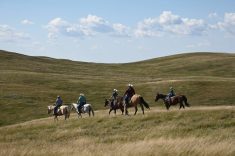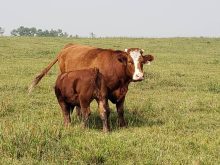Larger beef operations running smaller-framed mature cows tend to be the most profitable combination, according to cost of production (COP) information collected by Canfax Research Services.
That’s not an absolute statement. COP information from producers across the country over the past couple of years shows that some smaller operators with various-sized animals can be profitable as well.
But on average, the farms or ranches with 200 to 300 or more head running smaller-framed cows — between 1,200 and 1,300 pounds — tended to be the most profitable. The key is these larger operations tended to have higher returns and lower costs than smaller operators — generally the economies of scale improved profits.
Read Also

Harvest wraps up and fall work begins
At the Eppich famly ranch in western Saskatchewan, the fall harvest was successful with few breakdowns, cows and calves have been sorted and a new tractor has arrived
Creating benchmarks
Farm profitability and cow size are part of the information being collected through a three-year project known as the Canadian Cow-calf Cost of Production Network, says Canfax executive director Brenna Grant.
“It is important for producers, particularly when making marketing decisions, to know their cost of production and also know how their operations compare with other beef operations. So we were hoping as we collect this information it will provide producers with a useful benchmarking tool.”
Collecting data for the COP network is heading into the final year of the initial three-year project. The deadline for producers to join the program and provide data from their farms was the end of November, but as of early December, anyone interested in being part of the project in 2023 can contact Canfax by email at: [email protected] to see if there are still time or room to join. The COP network can offer participating producers a $500 honorarium funded by the Beef Cattle Research Council. The three-year project wraps up in 2023, but it’s hoped funding will be available to extend it.
As of 2022, the COP Network was comprised of 46 benchmark cow-calf farms and three dairy-beef farms, with data collected from 186 participants across Canada. (Note: information collected from participating farms in 2022 was based on 2021 production information. Many parts of the country 2021 experienced a very dry growing season).
Comparing similar operations
Canfax research analyst Huiting Huang explains that the information provided by the 186 farms from across Canada was analyzed to determine similarities between production practices. Farms with similar production practices were combined to create a benchmark.
For example, one of the Alberta benchmarks is described as: “a cow-calf operation in the Aspen Parkland region of Alberta, Canada. This operation keeps Hereford and Angus animals, with a beef cow herd of 152 head. The cow-calf enterprise is located on 2,622 ac, in a semi-arid climate with chernozemic and gleysolic soils. Mean annual temperature is 1.5 C, and mean annual precipitation is 450mm with the majority of precipitation falling May-June.”
Another benchmark for Saskatchewan is described as: “a cow-calf and yearling grasser operation located in the boreal transition ecoregion of Saskatchewan, Canada. This farm keeps Angus/Hereford cross animals, and maintains a beef cow herd of 350 head. The cow-calf enterprise is located on 3,083 ac. with predominantly black soils. Mean annual temperature is 1 C, and mean annual precipitation is 500mm.”
So again, from the information collected from 186 farms, they created 46 benchmark cow-calf operations. Anyone interested can log into the Canfax website, click on COP analysis and then find one of the benchmark farms that most closely resembles their operation. Producers can see how their production costs and returns compare with a similar benchmark operation.
More smaller cows
While the COP network covers a range of herd sizes, within provinces and nationally, Huang says data from these benchmark farms for the 2021 production year show that higher-profit farms tended to have more cows, smaller cows and lower costs per cow.
Herd sizes ranged from 35 head of beef cows to 950 head. Among the 46 benchmark cow-calf farms, 19 had fewer than 100 cows, 10 farms were in the 100-200 cow range, nine farms had between 201 and 300 and eight farms had more than 300.
The 2021 results indicated that farms with a larger herd were more likely to cover their cash and depreciation costs. In part, this refers to the operators being able to pay themselves a wage as well as being able to set money aside for capital costs such as machinery replacement.
For the two groups that had fewer than 100 or between 100-200 cows, only 47 and 50 per cent respectively were covering their cash and depreciation costs in 2021. Once the herd size gets over 200 head, the percentage of farms covering these costs increased to 75 to 89 per cent.
The major driving factor behind this pattern was the economies of scale, as larger herd operations were able to spread overhead costs over more cows. Grant says it doesn’t mean that smaller operations are necessarily going broke. It just indicates that smaller farms likely relied on other sources of income other than beef cattle — they either had cropping operations, diversified into some other enterprise or worked off-farm.
Cow size does matter
It was interesting to note that smaller cows played an important role in farm profitability.
Mature cow weights on the benchmark farms ranged from 1,200 lbs. to 1,540 lbs. with an average of 1,355 lbs. This is similar to the average mature cow weight reported in the 2017 western Canadian Cow-Calf Survey (1,374 lb.).
When all the benchmark farms were divided into three groups (namely low-, medium-, or high-profitable) based on net income, the high-profitable group in 2021 tended to have lighter mature cow weights — not by a huge amount, but enough to make a difference.
Looking at all benchmark farms, mature cow weights in the high-profitable group were an average of 47 lbs. lighter than the low-profitable group. Within the benchmark farms with fewer than 100 cows, the difference was even greater. Average mature cow weights in the high-profitable group were about 78 lbs. lighter than the low-profitable group.
For the farms with more than 100 cows, the medium-profitable group had the heaviest average mature cow weights, while the high-profitable group was about 20 lbs. lighter than the low-profitable group.
Figures show that smaller cows did result in fewer pounds of calf weaned and fewer pounds sold. As mature cow weights declined from the low- to high-profitable group, weaning weights also declined by 19 lbs. between the two groups. However, weaning weight as a percentage of mature cow weights was steady at around 41 per cent across the three groups.
Even though smaller calves meant fewer pounds of beef marketed, Huang says the lower costs of maintaining smaller cows appeared to offset the lower revenue on lighter calves and improved profitability. This may be particularly true for the drought-affected farms in 2021 given the skyrocketed feed prices and relatively stable cattle prices — it took less feed to maintain smaller cows.
Grant says information collected through the COP network sheds light on some of the commonalities of the profitable farms. The results showed that profitability did not relate to a specific production system, farm structure or region. Each operation had a unique approach to achieving financial success.
For more information on the Cost of Production Network visit the Canfax website at: https://www.canfax.ca and click on the “resources” button.
















